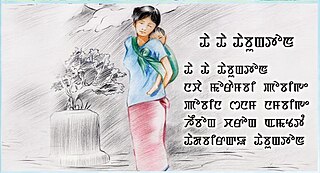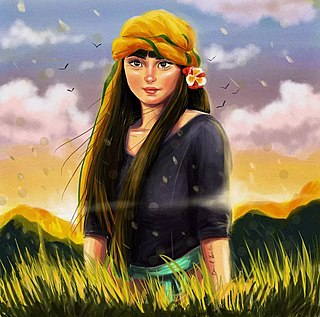
Sanamahism, also known as Meiteism, or Lainingthouism is an ethnic religion of the Meitei people of Manipur, in Northeast India. It is a polytheistic religion and is named after Lainingthou Sanamahi, one of the most important deities of the Meitei faith. Sanamahi is the eldest son of the supreme god Sidaba Mapu and the supreme goddess Leimarel Sidabi. Traditionally every Meitei household, irrespective of the religion, worships Sanamahi and Leimarel Sidabi. Sanamahism does not have a religious head but has a body, the Maru Loishang, that oversees the main religious activities and governs all affairs of the religion, including the conduct of priest and priestess. The Maru Loishang also acts a court for religious disputes. There are three main departments under the Manu Loishang, namely, the Amaiba Loishang, the Pena Asheiba Loishang, and the Amaibi Loishang. These departments have existed since the reign of King Meidingu Hongnemyoi Khunjao Naothingkhong of Manipur in 662 AD. Sanamahi is the eldest son of the supreme god Sidaba Mapu and the supreme goddess Leimarel Sidabi.
Lamphelpat is the district headquarter of Imphal West district in the state of Manipur, India. It is a suburb of Imphal city.
Thanga is an island village in the Loktak lake located in the Bishnupur district in the state of Manipur, India. In 2001, the population was 13085. 6514 were male. 6571 were female. The main occupation of this village is fishing. It is 55 km from Imphal, capital of Manipur.

Nongshaba is a lion god in Sanamahism and Meitei mythology. He is also regarded as a king of the gods. He is credited with producing light in the primordial universe and is regarded as the maker of the sun. He is worshipped by the people of both the Ningthouja clans as well as the Moirang clans. Nongshaba was worshipped by the people of Moirang clan as a lineage deity and regarded as the father of the god Thangching. He is the greatest of the Umang Lais but he made his only son Thangching the chief deity of Moirang.

In Meitei mythology and religion, Nongthang Leima is the goddess of seduction, thunder, and lightning. She was created by Atingkok to attract Haraba (Pakhangba). She mastered thunder and lightning in the chaos in the early world. She predicted the first rain. She limits the chaos and helps creation.
The Konthoujam Lairembi Stone Inscription Meitei: Konthoujam Lairembi Lairik Eeba Nungpaak) or Konthoujam Lairemma Stone Inscription is a Meitei language stone inscription found in a sacred site dedicated to Goddess Konthoujam Tampha Lairembi of Sanamahism in Konthoujam village of Manipur.

Laikhurembi is a goddess in Sanamahism, the indigenous religion of Manipur. She is the goddess of justice, good counsel, divine law, order and secrecy. She is the chief Queen of God Thongaren . She is the daughter of Lairen Humchouba. She is one of the divine incarnations of Leimarel Sidabi. She is one of the most important Umang Lais. Her pantheon is maintained particularly by the Taibungjam clan of Meitei ethnicity.

A Helloi or Heloi is a female nature spirit in Meitei mythology, folklore and religion. Hellois are often depicted in the forms of beautiful young women. They are often associated with seduction of men. They are the most powerful among the female spirits. They can cause diseases. The hellois are often known for their charming beauty, ecological balance and seduction of males. Hellois are sometimes seen as evil spirits in the forms of beautiful maidens.
Meitei Chanu is a Meitei language poem by Lamabam Kamal. It was first published in a magazine, with the same name, called Meitei Chanu (magazine) in the year 1924. It was republished in the author's book of his collection of poems called "Lei Pareng" in the year 1929. Its central theme is the reconfiguration of the identity of the Meitei people. The poem bountifully reflects the poet's love of his motherland and its heritage.

The Kangla Sanathong, also known as the Kangla Gate, is the western entrance gate to the Kangla Fort in Imphal West district of Kangleipak.

The Hijagang is a boathouse inside the Kangla Fort in Imphal, India. It houses four traditional Meitei watercraft, including two hiyang hirens and two tanna his. According to Meitei religious beliefs, the hiyang hirens are used by the male ancestral deity and female ancestral deity and are sacred to the Meiteis, the major ethnic group of Manipur.

The Manung Kangjeibung is an old polo field located to the south west of the citadel inside the Kangla Fort in Imphal West district of Manipur. In ancient times, only royalties and nobilities were allowed to play the game of polo in this royal playground. It is one of the two most ancient pologrounds in the world, the other one being the Mapal Kangjeibung .

Lairembigee Eshei, also known as Song of the Nymphs, is a Meitei language play, written and directed by Ratan Thiyam, performed by the "Chorus Repertoire Theatre" of Imphal. It was shown as a closing play at the 21st Bharat Rang Mahotsav at Kamani Hall in Delhi. It was staged on the concluding day of the 9th National Prayas Natya Mela. It was also staged as the concluding event of the three-day State conference on theatre organised by the Network of Artistic Theatre Activists Kerala (NATAK) in Kochi, Kerala.
The Nongmaiching Ching, also known as the Selloi Langmai Ching, is a mountain in Imphal Valley, Manipur. It has an altitude of around 5,133 feet (1,565 m). It is a holy pilgrimage site for the Meitei people. In Meitei mythology and religion (Sanamahism), it is a sacred mountain and the abode of God Nongpok Ningthou and Goddess Panthoibi. In Meitei folklore, the Nongmaiching is described as the hill that produces "the seven days of a week".

Tha Tha Thabungton is a traditional Meitei language lullaby. It is one of the Meitei folk songs traditionally sung by parents, usually mothers. It has reference to the aspects of bringing up their child, besides their biological relationship with their child. It also has reference to the musical harmony with the care of the child, which may also influence on the child's life and health.

Loktak Ima, also known as Loktak Lairembi, is the personification of the Loktak lake, who is revered by the Meitei people as the mother goddess of the sacred waters of the Loktak lake. She is highly respected and venerated by the fishermen communities of the Meitei ethnicity living in and around the periphery of the Loktak lake. She is also considered as the fountainhead of Meitei culture. Her embodiment, the Loktak lake is associated with the epic of Khamba and Thoibi as well as that of Poubi Lai of Meitei mythology and folklore.

Many Chings play significant role in different elements of Meitei culture, including but not limited to Meitei folklore, Meitei folktales, Meitei literature, Meitei mythology and Meitei religion (Sanamahism) of Kangleipak.

Women have significant roles in different elements of Meitei culture, including Meitei dances, Meitei festivals, Meitei folklore, Meitei folktales, Meitei literature, Meitei mythology, Meitei religion, etc.

Kumcha Lempi, also known as Kumja Lembi, is a woman in Meitei mythology and folklore of ancient Kangleipak. She is known for being a victim of an attack by a tiger in Khoirentak. Her tragedy is frequently mentioned, narrated and retold in the Moirang Kangleirol legends, usually by the Pena playing balladeers till present times.

Japanese people and Meitei people have a long history of sharing and interacting with each other's art and cultural heritages, including but not limited to cinema, music, mythology, language, literature and theatre.















